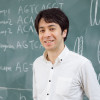セミナー
751 イベント
-
セミナー
A machine learning approach for prediction of mitochondrial proteins in non-model organisms
2021年2月12日(金) 10:00 - 11:00
久米 慶太郎 (筑波大学 医学医療系 助教)
The evolution of the repertoire of proteins localized to organelles is important for understanding the evolutionary process of organelles. However, experimental methods for identifying organelle-localized proteins have been established only for model organisms and some organisms. Therefore, prediction methods using sequence data obtained from genome and transcriptome analyses, which are relatively easy to obtain, are useful. However, such prediction methods had also been established only for model organisms. In this talk, I will introduce our study in which a machine learning method was used to obtain protein candidates localized to mitochondrion-related organelles in non-model organisms.
会場: via Zoom
イベント公式言語: 英語
-
セミナー
Quantum kinetic theory for chiral and spin transport in relativistic heavy ion collisions and core-collapse supernovae
2021年2月4日(木) 13:00 - 14:30
Di-Lun Yang (慶應義塾大学 理工学部 助教)
Recently, the anomalous transport phenomena of relativistic fermions associated with chirality and spin induced by external fields have been greatly explored in different areas of physics. Notably, such phenomena are in connection to various quantum effects such as quantum anomalies and spin-orbit interaction. The quark gluon plasmas produced from relativistic heavy ion collisions (HIC) and the core-collapse supernovae (CCSN) are both the systems in extreme conditions with high temperature or density and the presence of strong magnetic and vortical fields. Meanwhile, the abundance of light quarks and neutrinos as relativistic fermions created therein accordingly makes these two systems ideal test grounds for studying such exotic transport phenomena. Inversely, the anomalous transport may also give rise to unexpected impacts on the evolution of both systems. However, to analyze such dynamical quantum effects, a novel quantum transport theory delineating the evolution of chirality imbalance and spin has to be introduced. In this talk, I will discuss recent developments and applications of the quantum kinetic theory for chiral and spin transport in the context of HIC and CCSN.
会場: via Zoom
イベント公式言語: 英語
-
セミナー
System identification of mechano-chemical epithelial sheet dynamics
2021年2月4日(木) 10:00 - 11:00
浅倉 祥文 (京都大学 大学院生命科学研究科 博士課程)
Collective migration of epithelial cells is a fundamental process of multi-cellular organisms. Our recent study using live imaging with FRET-based biosensor discovered that cell migration within an epithelial sheet is oriented by traveling waves of ERK activation. However, it is still elusive how the cells make a decision on migration direction by integrating mechano-chemical signals. Here, we performed reverse-engineering approach to extract a hidden control mechanism in the epithelial sheet dynamics in a data-driven manner. Our model has an ability to forecast cell migration quantified in time-lapse images. Therefore, our approach would be powerful to understand mechano-chemical epithelial sheet dynamics.
会場: via Zoom
イベント公式言語: 英語
-
セミナー
Mathematics of magic angles for bilayer graphene
2021年2月3日(水) 20:00 - 21:15
Simon Becker (Ph.D. Student, Department of Applied Mathematics and Theoretical Physics, University of Cambridge, UK)
20:00pm ~ 21:15pm on Feb. 03th, 2021 (JST) 11:00am ~ 12:15am on Feb. 03th, 2021 (UK) Magic angles are a hot topic in condensed matter physics: when two sheets of graphene are twisted by those angles the resulting material is superconducting. Please do not be scared by the physics though: I will present a very simple operator whose spectral properties are thought to determine which angles are magical. It comes from a recent PR Letter by Tarnopolsky–Kruchkov–Vishwanath. The mathematics behind this is an elementary blend of representation theory (of the Heisenberg group in characteristic three), Jacobi theta functions and spectral instability of non-self-adjoint operators (involving Hoermander’s bracket condition in a very simple setting). The results will be illustrated by colourful numerics which suggest some open problems. This is joint work with M. Embree, J. Wittsten, and M. Zworski.
会場: via Zoom
イベント公式言語: 英語
-
セミナー
Many body problems from quarks to stellar evolutions
2021年1月28日(木) 13:30 - 15:00
安武 伸俊 (千葉工業大学 情報科学部 教育センター 准教授)
The many-body problems are major problems that need to be clarified not only in nuclear physics, but also in astronomy. In this seminar, I introduce stellar evolutions as gravitational many-body problems, and also hadronic matter as quantum many-body problems, based on the Lagrangian schemes. The macroscopic stars and the microscopic hadronic matter look completely different issues. But in this seminar, I introduce the similarities between the two problems. For hadronic matter, we adopt the color molecular dynamics to understand the behaviors and properties of hadronic matter in the framework of QCD. Although molecular dynamics can not be the first-principle, they are sometimes useful to understand many-body quantum properties. In this talk, we introduce the current status of our color molecular dynamics.
会場: via Zoom
イベント公式言語: 英語
-
セミナー
Numerical inference of the molecular origin of the cyanobacterial circadian rhythm
2021年1月28日(木) 10:00 - 11:00
甲田 信一 (分子科学研究所 計算分子科学研究領域 助教)
The cyanobacterial clock proteins, KaiA, KaiB, and KaiC, are known as the simplest biological clock; Just by mixing them with ATP in a test tube, self-sustaining oscillation with a nearly 24h temperature-compensated period is reconstituted. To elucidate the molecular mechanisms of this oscillator, experimental studies have revealed and investigated in detail various elementary reactions/processes, ranging from local chemical reactions of ligands to global (dis)assembly of the proteins. Yet, proposing molecularly detailed mechanisms of the clock functions is still difficult because almost all experimentally measurable quantities are the results of complicated interplays between many elementary processes, i.e. independent measurement of an elementary process is difficult. In this talk, I will present a numerical approach to obtain the rate constants of the elementary processes from experimental data [1, 2]. First, a reaction model consisting of rate equations of the elementary processes is built. Then, their rate constants and temperature dependence are inferred by simultaneously fitting model outputs to multiple types of experimental data (such as phosphorylation reactions and ATPase activity) at various temperatures. On the basis of the inferred parameter values, we can quantitatively discuss how the clock functions arise from the interplays between elementary processes. As an example, I will present a potential molecular mechanism of the temperature compensation of period.
会場: via Zoom
イベント公式言語: 英語
-
セミナー

Journal Club: Sampling the stable structures based on replica-permutation method
2021年1月27日(水) 13:00 - 14:30
横田 宏 (理化学研究所 数理創造プログラム (iTHEMS) 特別研究員)
When we want to search the (meta)stable structures of the macromolecules such as protein, the combination of molecular dynamics simulation and replica exchange method (REM) is useful. In REM, sampling is performed by exchanging replicas (copies) of the system having different temperatures when this process is accepted based on Metropolis algorithm. In this method, the exchange can be rejected, which leads to the decrease in the sampling efficiency. To obtain more efficient sampling than that of REM, Itoh and Okumura proposed replica-permutation method (RPM) in which the replicas are permutated to perform sampling based on Suwa-Toudou algorithm. In this Journal club, I will introduce RPM and some examples of its application.
イベント公式言語: 英語
-
セミナー

Introduction to Boolean modeling and Boolean networks as information processing units
2021年1月21日(木) 10:00 - 11:00
岡田 崇 (理化学研究所 数理創造プログラム (iTHEMS) 上級研究員)
Boolean networks are widely used in physics, biology, social science, and computer science. In this talk, I will introduce the basics of Boolean networks and give an overview of Biological applications. Then, I will discuss information transfer in Boolean networks and discuss optimal design principles. The latter part of the talk is based on joint work with Fumito Mori (Kyushu Univ).
会場: via Zoom
イベント公式言語: 英語
-
セミナー

Information theory in ecology: Markov chain, Venn diagram, Kronecker (and Cartesian graph) products, and Tsallis entropy
2021年1月20日(水) 13:00 - 14:00
入谷 亮介 (理化学研究所 数理創造プログラム (iTHEMS) 研究員)
This is more like an introductory talk on how I was motivated to work with information theory, and include unpublished data. Ecologists have been long interested in understanding diversity (divergence) of natural ecosystems. One possible way of accounting for diversity is to use a species' presence/absence table across spatial locations (species-location table), in which we record 1 if a focal species is present in a given site (otherwise 0). Recent interest lies in assessing how diversity (e.g., the number of species) changes with time: for instance, extinction and colonization of species may result in the modification of such tables with time. However, we are yet to have theoretical toolkits to model the dynamics of spcies-site tables. In this talk, I will introduce my model (in collaboration with R. Hamazaki, S. Tatsumi, and M Cadotte) of the dynamics of species-site tables based on Markovian stochastic processes. Specifically, our apporach allows us to analytically obtain the solution of the full stochastic dynamics by means of localizing the dynamics to a single site and then expanding it towards the global sites with Kronecker's prodcut (in linear algebra) or Cartesian product (in graph theory). Intuition obtains from illustrating the dynamics onto Venn diagram, where we draw several sets (corresponding to locations) and binary numbers (corresponding to presence-absence data) and consider random walks on Venn diagram acorss sets; also this Venn diagram based interpretation is mathematically underpinned by Cartesian product of graphs. Finally I will briefly talk about how we assess diversity of ecosystems using Tsallis entropy (or the generalized Shannon entropy).
会場: via Zoom
イベント公式言語: 英語
-
セミナー
Time-dependent driven quantum critical systems in (1+1) dimension
2021年1月18日(月) 10:00 - 11:15
Xueda Wen (Postdocs, Physics Department, Harvard University, USA)
10:00am ~ 11:15am on Jan. 18th, 2021 (JST) 8:00pm ~ 9:15pm on Jan. 17th, 2021 (EST) I will introduce an analytically solvable setup for time-dependent driven quantum critical systems in (1+1)D, whose low-energy physics are described by conformal field theories. In general, one may observe two different phases (heating and non-heating), where the correlation functions such as the entanglement entropy and energy-momentum density can be analytically solved. The dependence of phase diagrams on (i) the types of driving Hamiltonians and (ii) the types of driving sequences (such as periodic, quasi-periodic and random drivings) will be discussed.
会場: via Zoom
イベント公式言語: 英語
-
セミナー

What are genes and how can we find them?
2021年1月14日(木) 10:00 - 11:00
ジェフリ・フォーセット (理化学研究所 数理創造プログラム (iTHEMS) 上級研究員)
Although 'gene' is a word that is used frequently in the society, most people probably do not know what genes actually are. In fact, its definition is not so straightforward. In this talk, I will first give a historical perspective and our current understanding of what genes are and what they look like. Then, I will talk about 'gene prediction'. Once we obtain the DNA (genome) sequence data of a given species, we must 'find' the genes within the genome. This involves computational prediction utilizing probabilistic models and various sources of external evidence. I will briefly explain how this is done.
会場: via Zoom
イベント公式言語: 英語
-
セミナー

Accelerated equilibration in classical stochastic systems
2021年1月13日(水) 13:00 - 14:00
足立 景亮 (理化学研究所 数理創造プログラム (iTHEMS) 基礎科学特別研究員 / 理化学研究所 生命機能科学研究センター (BDR) 生体非平衡物理学理研白眉研究チーム 基礎科学特別研究員)
Shortcuts to adiabaticity (STA) [1] are processes that make a given quantum state evolve into a target state in a fast manner, which can be useful to avoid decoherence in quantum experiments. In this journal club, I will concisely review the concept of STA, and then focus on the recently proposed classical counterparts of STA, sometimes called engineered swift equilibration, in Brownian particle systems [2] and evolutionary systems [3].
会場: via Zoom
イベント公式言語: 英語
-
セミナー
From local resynchronization to global pattern recovery in the zebrafish segmentation clock
2021年1月7日(木) 10:00 - 11:00
瓜生 耕一郎 (金沢大学 生命理工学類 助教)
Tissue-scale developmental patterns are often generated by local cellular interactions and global tissue deformation. An example is gene expression rhythms in vertebrate, termed the segmentation clock. The oscillatory spatial pattern of the segmentation clock across a tissue determines the timing of body segment formation. In this seminar, we discuss pattern recovery in the zebrafish segmentation clock after perturbation in oscillator coupling. To predict pattern recovery in embryos, we develop a physical model that describes both cell mechanics and genetic oscillations. We show that the physical model explains experimentally observed intermingled segmental defects, and their axial distributions in different embryonic developmental stages. Our analysis suggests that pattern recovery in developing tissues occurs at two scales; local pattern formation and transport of these patterns through tissue morphogenesis.
会場: via Zoom
イベント公式言語: 英語
-
セミナー

Review on the Lieb-Robinson bound
2020年12月23日(水) 13:00 - 14:00
後藤 ゆきみ (理化学研究所 数理創造プログラム (iTHEMS) 基礎科学特別研究員)
The Lieb-Robinson bound is inequality on the group velocity of information propagation for quantum many-body systems. In this talk, I review this bound mathematically and explain some consequences of the bound.
イベント公式言語: 英語
-
セミナー

Mathematical model-based quantitative data analysis for COVID-19
2020年12月22日(火) 10:00 - 11:00
岩見 真吾 (九州大学 大学院理学研究院 生物科学部門数理生物学研究室 准教授)
The recent spread of corona threatens the health of people around the world. We urgently need strategies to reduce COVID-19 spread and to enhance antiviral drug development for individual patients. Mathematics could contribute to control of COVID-19 pandemic by informing decisions about pandemic planning, resource allocation, and implementation of social distancing measures and other interventions. My group is conducting interdisciplinary research to elucidate "Quantitative Population Dynamics" with original mathematical theory and computational simulation, which are both our CORE approach. Our mathematical model-based approach has quantitatively improved a current gold-standard approach essentially relying on the statistical analysis of "snapshot data" during dynamic interaction processes in virus infection. In my talk, I would like to discuss how our approach improves our current understanding of COVID-19 research, and help an establishment of a "standard antiviral treatment" for COVID-19 as well.
会場: via Zoom
イベント公式言語: 英語
-
セミナー

Classical liquids and functional renormalization group
2020年12月17日(木) 13:00 - 14:30
横田 猛 (東京大学 物性研究所 特別研究員)
Development of methods for classical statistical mechanics is desired for accurate predictions of the structures and thermodynamic properties of liquids. A powerful framework to describe classical liquids is density functional theory (DFT). In the quantum case, there have been recent attempts to develop accurate methods with combining DFT and the functional renormalization group (FRG), which is another framework to deal with many-body systems utilizing evolution equations, and such approaches are expected to work also in the classical case. In this presentation, I will talk about a new approach for classical liquids aided by FRG. The formalism and some ideas to incorporate higher-order correlation functions to systematically improve the accuracy will be shown. I will also present a numerical demonstration in a one-dimensional exactly solvable system and discuss the results by comparing to other conventional methods such as the hypernetted chain.
会場: via Zoom
イベント公式言語: 英語
-
セミナー
Autoimmune diseases initiated by pathogen infection: mathematical modeling
2020年12月17日(木) 10:00 - 11:00
原 朱音 (九州大学 システム生命科学府 一貫制博士課程)
The pathogen with proteins similar to host’s proteins is likely to cause autoimmunity, which is called “molecular mimicry”. To understand the mechanism of autoimmunity development caused by pathogen infection, we considered the following scenario: the infection activates the immune system, which results in clearance of pathogens, and the enhanced immune responses to the host’s body may remain and attack the host’s cells after the pathogen clearance. We developed a mathematical model describing the dynamics of T helper (Th) cells, viruses, self-antigens, and memory T cells and identified the conditions necessary to realize the scenario. We considered the cross-immunity of three different modes of action: [1] virus elimination by Th cells reactive to the self-antigen, [2] activation of Th cells reactive to viruses by self-antigens and Th cells reactive to self-antigens by viruses, and [3] enhancement of immune responses to self-antigens by Th cells reactive to viruses after the infection. The cross-immunity of type [3] was found to be most important for autoimmunity development. In contrast, [1] and [2] suppressed autoimmunity by effectively decreasing the viral abundance.
会場: via Zoom
イベント公式言語: 英語
-
セミナー

Quantum Wasserstein distance of order 1
2020年12月16日(水) 13:00 - 14:30
濱崎 立資 (理化学研究所 数理創造プログラム (iTHEMS) 上級研究員 / 理化学研究所 開拓研究本部 (CPR) 濱崎非平衡量子統計力学理研白眉研究チーム 理研白眉研究チームリーダー)
The Wasserstein distance is an indicator for the closeness of two probability distributions and is applied to various fields ranging from information theory to neural networks [1]. It is particularly useful to treat the geometry of the underlying space, such as tensor-product structures. In this journal club, I talk about one of the recent proposals on quantum extension of the Wasserstein distance [2]. After reviewing basic properties of classical Wasserstein distance, e.g., its relation to concentration phenomena, I discuss how they might be generalized to quantum realm.
会場: via Zoom
イベント公式言語: 英語
-
セミナー
Statistical model for meaning representation of language
2020年12月16日(水) 10:30 - 12:00
吉野 幸一郎 (理化学研究所 科技ハブ産連本部 (RCSTI) ロボティクスプロジェクト チームリーダー)
One of the final goals of natural language processing is building a model to capture the semantic meaning of language elements. Language modeling is a recent research trend to build a statistical model to express the meaning of language. The language model is based on the distributional hypothesis. The distributional hypothesis indicates that the surrounding elements of the target element describe the meaning of the element. In other words, relative positions between sentence elements (morphologies, words, and sentences) are essential to know the element's meaning. Recent works on distributed representation mainly focus on relations between clear elements: characters, morphologies, words, and sentences. However, it is essential to use structural information of languages such as dependency and semantic roles for building a human-understandable statistical model of languages. In this talk, we describe the statistical language model's basis and then discuss our research direction to introduce the language structure.
会場: via Zoom
イベント公式言語: 英語
-
セミナー
Non-perturbative tests of duality cascades in three dimensional supersymmetric gauge theories
2020年12月14日(月) 16:00 - 18:10
久保 尚敬 (京都大学 基礎物理学研究所 特別研究員)
M2-brane is an interesting object in M-theory and string theory. A three-dimensional ?=6 super conformal Chern Simons theory with gauge group U(?1)×?(?2), called ABJ theory, describes the low energy behavior of M2-brane On the one hand, it has been considered that when |?1−?2| is larger than the absolute value of Chern Simons level, the supersymmetry is broken. On the other hand, it was predicted that an interesting phenomenon called duality cascade occurs, and supersymmetry is not broken in some cases. Motivated by this situation, we performed non-perturbative tests by focusing on the partitionfunction on ?3. The result strongly suggests that the duality cascade indeed occurs. We also proposed that the duality cascade occurs in theories with more general gauge groups and we performed non-perturbative tests in the same way. I will review and explain our physical prediction in the first half of my talk. In the second half of my talk , I will explain the non-perturbative tests . This part is mathematical because the partition function reduces to a matrix model by using the supersymmetric localization technique.
会場: via Zoom
イベント公式言語: 英語
751 イベント
イベント
カテゴリ
シリーズ
- iTHEMSコロキウム
- MACSコロキウム
- iTHEMSセミナー
- iTHEMS数学セミナー
- Dark Matter WGセミナー
- iTHEMS生物学セミナー
- 理論物理学セミナー
- 情報理論SGセミナー
- Quantum Matterセミナー
- ABBL-iTHEMSジョイントアストロセミナー
- Math-Physセミナー
- Quantum Gravity Gatherings
- RIKEN Quantumセミナー
- Quantum Computation SGセミナー
- Asymptotics in Astrophysics SG Seminar
- GW-EOS WGセミナー
- DEEP-INセミナー
- NEW WGセミナー
- Lab-Theory Standing Talks
- 場の量子論セミナー
- STAMPセミナー
- QuCoInセミナー
- Number Theory Seminar
- 産学連携数理レクチャー
- Berkeley-iTHEMSセミナー
- iTHEMS-仁科センター中間子科学研究室ジョイントセミナー
- RIKEN Quantumレクチャー
- 作用素環論
- iTHEMS集中講義-Evolution of Cooperation
- 公開鍵暗号概論
- 結び目理論
- iTHES理論科学コロキウム
- SUURI-COOLセミナー
- iTHESセミナー
